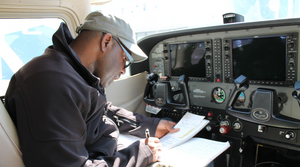How to become a Pilot

I was in your shoes just a few years ago. Growing up, it was my dream to become a pilot but I was discouraged from pursuing my dream. Even one of my high school teachers (Mr. Webb) laughed and told me to be realistic about my aspirations of becoming a pilot. Thankfully, I am not the type of person that is easily discouraged. Although many years passed, my burning desire to become a pilot was still intact and it reached a tipping point after my first visit to AirVenture in Oshkosh WI.
The experience from attending AirVenture inspired me to go out and pursue my dream and become a pilot. As soon as I arrived home from Oshkosh, I started researching flight schools in my area and the requirements for becoming a pilot. I immediately bought materials, joined EAA and AOPA, started flight lessons, and started studying for the written exam. Ten months after leaving AirVenture, I was finally a licensed pilot.
Despite what you've heard, becoming a pilot is easier than you think. If you can learn to ride a bike or drive a car, you can also learn to fly an airplane and become a pilot. And as a pilot, the sky truly is the limit.
Step 1: Decide what you want to fly
The first step in becoming a pilot is really to decide what you want to fly. Do you want to fly airplanes, helicopters, gyroplanes, or gliders? Or maybe you fancy hot air balloons. You can't go wrong with any of those but keep in mind that FAA rules for getting a pilot's license differ depending on the type of aircraft you fly. You should also think about what type of flying you want to do. There are several different types of pilot's licenses, from student pilot all the way up to airline transport pilot.
Step 2: Research flight schools
Find a flight school that best suits your needs. Do some research online to find flight schools in your area. Pick a few schools and read the reviews from past students. Visit as many schools as you can from your list and talk to the flight instructors (CFIs). Before you commit to training, ask if you can get a demonstration or introductory flight. There may be a small fee for the demo flight but this will give you a sense of what it is like to fly in a small airplane and it will also help you decide if a particular instructor is the right fit. It is important to choose a flight instructor with whom you will feel comfortable.
Step 3: Get your medical certificate
Once you've selected a flight school and instructor that you are comfortable with, the next step is to get your medical certificate (third-class medical). This is an important step because the last thing you want to do is start taking lessons, invest time and money only to find out that a medical issue prevents you from getting your pilot's license. Since you must have your medical certificate before your first solo, you should get this out of the way first, so you can discover early on whether or not you have health issues that would impact your ability to fly and to get your license.
Step 4: Get your student pilot certificate
In addition to the medical certificate, a student pilot certificate must be obtained before you are allowed to solo. The easiest way to get your student pilot certificate is to apply online through the FAA's Integrated Airman Certification and Rating Application (IACRA) website. You can also visit your local Flight Standards District Office (FSDO) in person, or talk to your flight instructor. He or she can certainly help with this.
Step 5: Hit the books and pass the FAA Knowledge Test
There are many subjects that you'll need to study and master before you can become a pilot. The ground school portion is where you'll obtain the required aeronautical knowledge as well as flight and aircraft operational procedures necessary to pass the FAA written exam and go on to become a successful and competent pilot. You’ll study subjects such as aerodynamics, aircraft systems, flight planning, FAA regulations, aviation weather, aircraft navigation, stall/spin awareness, aeromedical factors, and National Transportation Safety Board (NTSB) incident/accident reporting requirements. You can certainly complete ground school as part of your flight school training as well but the easiest and most cost-effective way is through a self-paced home-study program such as using our Gleim Ground School Kit. I personally used the Gleim program and aced my FAA written exam. Once you’ve completed the ground portion of the training, you will take the “written” FAA test, which is actually a computer-based multiple-choice exam aimed at testing your knowledge of the concepts covered in ground school. You'll need to pass this test with a grade of 70 percent or better.
Step 6: Start flight training lessons with a CFI
Now we come to the fun and exciting part. This is where you’ll learn aircraft systems, how to perform takeoffs, landings and all the required maneuvers such as steep turns and slow flight. Get yourself a great headset. You will learn how to communicate effectively as you handle radio communications and put your knowledge of airport operations, ground reference and emergency procedures into practice. After about 10-20 hours learning and flying with your instructor, you will be "set free” and be allowed to fly solo (without your instructor in the airplane). Typically your first solo is limited to the traffic pattern and you will practice a few takeoffs and landings while your instructor observes from the ground. This is an exciting experience, and one the most memorable parts of the whole experience so savor every moment of it.
After you've successfully completed your first solo flight, your instructor will take a pair of scissors and cut out the back of your shirt (cutting the tail) so wear an aviation themed t-shirt as you will keep a portion of this shirt forever. Cutting of the shirttail is a right of passage — it is a sign of your instructor’s new confidence in you, symbolizing that you no longer need the instructor’s hands-on assistance.
After a few more lessons and a couple of cross-country trips, you will be ready for your check ride.
Step 7: You've done it. Time for the check ride
This is it. You've done it. You've come a long way and you should be very proud of yourself. The check ride is the final step and consists of both an oral and practical test of the skills you've learned over the last few months.
Congratulations you are now a pilot. Welcome to the club. Go out and take your friends, or significant other on a trip. Fly out for a $100 hamburger you deserve it. See you in Oshkosh.
Thanks for reading the entire post. As a special thank you for reading the full blog, here is a coupon code for $25 off any Hobbs Flyer H2 headset: H2BLOG06.
#flysafe

